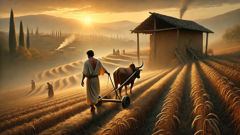Introduction
In the hills and hollows of ancient Greece, water was never merely water. It was a voice, a memory, a presence that answered to a name older than the stone of temples and older than many of the songs mortals still sang at dusk. Look closely at a spring and you could see more than the glint of sunlight on clear water; you could glimpse the slow uncoiling of a certain attention, the careful watchfulness of the Naiads. These nymphs—daughter-spirits of freshwater—dwelt where the land gave up its secret: wells that tasted sweet, fountains that always ran, springs that would not dry in drought, rivulets that braided through olive groves. Each Naiad belonged to a place as surely as roots belong to a tree. They were not interchangeable; the well behind the baker’s house held a Naiad whose humor was as crisp as the bread baked that morning. The high-mountain spring that fed a shepherd’s bowl kept a Naiad who spoke in a voice like ice and bell-metal. The city fountain, carved with lion faces and tended by priests, sheltered a Naiad who had learned to keep many faces—gracious to pilgrims, secretive to lovers, stern with those who struck the water with greed. From their vantage, Naiads watched the braided lives of people and beasts whose survival depended on their vigilance. They taught the young to wade safely, tested the faithful with riddles that tasted like river-stone, and punished those who defiled their sources with careless hands. Yet they were not mere guardians; they were memory-bearers. In their reflections and ripples were stored fragments of old promises, vows made beneath star-leaning roofs, the first names of lovers who had drunk together, and the curses dropped in the heat of harvest. To call a Naiad by her name was to open a ledger of small mercies and old debts. In this story I will lead you to three springs, three wells, and the fountain at the city’s heart. I will introduce you to Naiads who laugh like brooks, who brood like deep pools, and who sing the long, patient songs of water itself. Along the way you will meet mortals—hermits, priests, children, and kings—whose lives became braided with the nymphs’ in ways that altered both banks of muddy history. We will move through ritual and rumor, through loss and tenderness, and we will listen for the lesson the Naiads have kept for generations: water remembers what we forget, and in the remembering live both mercy and reckoning.
Origins, Names, and the Language of Springs
Naiads were older than the neat hymns of city priests but younger than the rivers that cut canyons into the bedrock. In the beginning—if a beginning is the right way to think about something that slouches like a season—the world’s freshwater gathered itself into a chorus. Springs bubbled where underground veins found light. Wells were dug and became homes, and fountains were set in plazas so a city’s heart could pulse with liquid rhythm. The Greeks noticed this chorus and gave it names. Local people spoke of nymphs as persons of place: the Spring-Mother of Lerna, the Well-Maiden behind a woman’s cottage, the Brook-Sister who braided her hair with reeds. Each Naiad had etymological ties to the water they served; their names read like maps and prayers. Scholars later traced these names to root-words for ‘flow’ and ‘gift,’ for ‘coolness’ and ‘hiddenness.’ But to those who lived closest to the springs, a Naiad's name was not only a word but a summons. When a child learned the name of the well-nymph, she learned how to lift a pail so the bucket did not scrape the stone and disturb the Naiad’s sleep. When a husband blessed a wife at the fountain, he offered a small coin to the Naiad’s custody as a token that the household would treat the water with reverence. Names thus became law and song. They bound people to practice and practice to place. In village altars and city shrines, small icons depicted Naiads with reeds in their hair or with water-lilies at their throats. But the real Naiads were not captured by pigment or marble. They were cunning and tactile. Some lived right at the water’s edge, where their skin took on the scent of algae and river-stone; they could slip between the reflective face of a pool and the wet soil beneath the reed-banks. Others favored the cool dark of wells and made their homes beyond the reach of daylight, their voices echoing up the shaft like music in a jar. A Naiad’s temperament matched the character of her source. Mountain springs tended toward clarity and abruptness; their nymphs were brisk, answerable, and quick to thwart cattle that drank too greedily. Stagnant ponds grew more secretive, brooding; their Naiads kept collections of lost things—ribbons, rings, the sighs of those who had drowned in regret. The greatest of Naiads served not a single well but a domain: the streams that fed a valley or the network of cisterns under a town. Their personalities were complex, layered like the strata of soil. People spoke of manners and rituals around the Naiads. Offerings were small and practical: a libation poured at dawn, a braid of herbs hung on a stone, a child’s first hair offered at the spring to ensure health. Priests sometimes organized larger observances, asking for the Naiads’ favor before irrigation or harvest. In return, the Naiads offered continuity. They regulated water for crops, they kept wells from fouling, they could hide the path of a dry season by diverting an underground trickle to the thirsty field. Yet their generosity was never unconditional. If a field was overrun with greed—a landowner stealing more water than the communal rules allowed—that’s when a Naiad would run colder, the spring grow thin, and the community would have to reckon. Mythic narratives captured this balance. Stories of mortals who bargained with Naiads were parables sewn into daily life: a miller who offered a daughter’s dowry to a stream and found his children washed away in consequence; a young woman who plaited her hair with laurel and saved her village by wading into a flooded gorge to plead with the Naiad whose rage churned the water. These tales taught an ethic—use, but do not despoil; take, but remember the source. They also taught a subtler truth: water remembers what we forget. A Naiad might keep the echo of a promise for decades. A bride’s whispered vow at a fountain could bloom into protection for her grandchildren. The memory was not judgment alone; it was the archive of domesticities. The tales the Naiads harbored included everyday kindnesses that never made it to heralds’ songs: the woman who tended lost calves at the riverbank, the man who rescued a child from a whirlpool, the mother who washed her newborn at a spring and sang into the nymph’s ear for safe sleep. Through such stories, springs became moral agents in the human imagination. They taught patience, accountability, and reciprocity. Beyond moral uses, Naiads were woven into the civic and poetic culture. Poets addressed them in elegies and serenades as guardians whose favor could soften the sheen of a king’s decree or whose displeasure could tarnish a banquet’s mirth. Sculptors carved figures with anatomies that hinted at amphibious grace—a torso like marble, a waist wrapped in water-lily patterns, hair that fell as though it were still wet. And yet all representation remained a shadow of the living Naiads. The living presence was an experienced thing, encountered in the everyday: the sudden coolness of well-water drawn on a scorching noon, the shimmer of foot-prints crossing a sandbar that had not been there the day before. In such moments, people knew they were touched by something continuous and sovereign. For the Naiads themselves, existence was a long stewardship. They aged in seasons rather than years, marked by what the land had borne: droughts thick with grief, springs swollen with rain, the slow trimming of human hands that reshaped banks for mills and baths. They saw infrastructures arise—bridges, aqueducts, cisterns—and learned to live around them. Some Naiads resented the stonework that bordered their streams with hard edges; others welcomed it, discovering that carved channeling made it easier to feed more households. Their stories thus include adaptation as well as resistance. Above all, the Naiads embodied a relational ontology: water does not give without relation, and people cannot take without owing.

Ritual, Reckoning, and the Lives Entwined with Water
Ritual gave form to human devotion to Naiads, and through ritual the Naiads’ presence entered civic life. Every year certain communities held rites by the water: women fasting at the edge of a spring, priests casting bowls of honey and barley into wells to ask for fertility, children running to the fountain with garlands and small coins. These acts were practical and symbolic. They were meant to keep the water clean, to remind the community that water was finite and relational, and to keep the Naiads from taking offense. The rites varied: in some regions the offering was a cup left full under the stars, in others a song performed at dawn. The greatest and most solemn rites occurred when the community faced a crisis—drought, plague, or the sudden spoiled taste of the town’s cisterns. In those moments, a Naiad might be asked to speak through a conduit: dreams, sudden clear voices at the spring, or omens in the fish that swam near the pool. The priestly class sometimes formalized such signs, but often the signs were ordinary and uncanny. A shepherd hearing the spring call his lost sheep by name, an old woman whose hand was steadied by a cool current when she feared falling—these were the sorts of communications that built trust between mortals and Naiads. Yet there were darker edges to the relationship. The Naiads were not immune to grief or wrath. They were as capable of vengeance as they were of mercy, and their memory could be long and exacting. Many stories turn on transgression—a thrown pot, a child left to drown, an oath broken under the water’s skin. In one such tale a landowner diverted a stream to water his newly acquired fields, ignoring the communal easement that ensured all had access. The Naiad of the original channel began to hoard the spring’s voice; the diverted fields warmed but did not yield as expected, and the landowner’s own household suffered thirst as punishment. The community’s elders had to meet, pray, and restore the original channel, offering woven rings and a public apology at the spring’s lip. The Naiad removed her grievance only when the apology was honest and the water shared as before. The moral structure was not merely punitive. The Naiads taught complex lessons about reciprocity and humility. They showed that central resources—water chief among them—could not be privatized without cost. They were social critics in their own right. At times the Naiads took a more intimate role. Lovers met at springs to test fidelity because a Naiad would not stand for duplicity. A husband who swore a false oath at the well and then plotted to steal his wife’s goods might find his voice caught in the water and unable to lie without coughing up the truth. A woman who could not bear children would go to a particularly patient Naiad who kept names of midwives and stored lullabies in her pool; the woman would be asked for a token in return—a promise of future care for the Naiad’s favored reed-bed, or the promise that her child would learn the place’s name and the duties that came with it. Children, perhaps more than any other class, had the most intimate encounters. They were small enough to stand at a water’s edge and bend to meet a Naiad’s reflection as an equal. A Naiad often became an invisible godmother, telling a child where the fish favored a certain reed or warning of a deep hole in the riverbed. Parents taught their children songs and names by the spring to ensure the Naiad’s favor. Thus the Naiad’s role knitted generations together, imprinting memory onto everyday practice. Some of the most moving narratives involve displacement and diaspora. When populations moved—fleeing war, famine, or decisions by rulers—the Naiads could not always follow. They remained with the land. Those who left often carried nostalgia like salt in their mouths, and they told stories to preserve the presence of the Naiads in new towns far from the old springs. Refugees would recount the names of wells back home, instructing their children to keep them. These translations of place into speech became forms of resistance against erasure. When cities expanded and architects redirected streams into buried pipes, citizens sometimes found the public water tainted by rust or tasteless. The cultural memory of Naiads provided a vocabulary for lament and protest. Citizens argued that while hydraulic engineering could move water, it could not buy the Naiad’s blessing. Politicians who dismissed this saw unexpected consequences—epidemics of bad water, and social unrest guided by people who believed the land’s stewardship had been violated. On the other hand, engineers and civic leaders who treated water and its guardians with respect often found creative collaboration. There are accounts of aqueducts built with ritual niches: small recessed shrines where an offering could be left to the Naiad whose waters flowed through the channel. Such compromises allowed modern infrastructure to coexist with older beliefs. The Naiads, in arc and practice, became hybrid beings of myth and municipality. Their stories include moments of deep tenderness that resist the purely instrumental reading of nature-spirits. A particular spring, tucked beneath cypress trees and shaded by an abandoned shrine, once became a refuge for an outlaw. He was a man softened by grief: his wife had died in childbirth, and he had been exiled for a theft he swore he did not commit. For years he lived by the spring, keeping it clean and singing to the Naiad. He left no offerings of gold, only small things—a patched blanket, a carved wooden bird. In time, villagers began to bring him bread and to exchange for his stories about the Naiad who slept beneath the water. The outlaw—who had been judged wrongly—found a form of redemption in tending the spring and recording the names of those who passed. When he died, his body was found tucked into reed-beds, and the Naiad’s reflection lay untroubled on the pool. The villagers saw a sign of reconciliation: the Naiad had accepted him not because of his past but because of the care he showed. Such stories produce a sensibility: the Naiads are not abstract forces but moral mirrors. They respond to small acts of attention. They reward patience, care, and the willingness to listen. They resist domination and amnesty those who alter their behavior. Their fickleness is not arbitrary but relationally rational. In epic tales the Naiads sometimes crossed into the domain of gods and heroes. They aided swimmers, guided lost kings, or warned of ambushes by whispering in a soldier’s ear. They also fell in love with mortals, producing lineages that blurred gods and men. Yet these romantic episodes rarely end like the courtly romances; they are anchored in consequence. When a Naiad loved a mortal, she changed the tide of her own attention and exposed herself to mortal frailty—jealousy, betrayal, exhaustion. Some Naiad-mortal unions dissolved into tragedy; others produced unexpected hybrids: folk healers whose cures derived from the supernatural knowledge of springs, poets whose metaphors were quite literally borrowed from Naiadic speech. Over centuries, artists, playwrights, and storytellers reimagined the Naiads. Aesopic fables used them as moral agents in tales that taught civic virtue; lyric poets used their images to explore desire and mourning; dramatists staged scenes where the Naiad’s voice echoed through a chorus of actors to reveal communal guilt. The modern ear might hear in these plays not just the old supernaturalism but a persistent ecological intelligence. The Naiads were early conservators: a culture’s attempt to bind human behavior to the stewardship of a shared resource through law, ritual, and story. To live near a stream in ancient Greece was to learn a curriculum: a sense of restraint, of notice, and of repair. The teachings that passed through Naiad stories have contemporary implications. In a world where water systems are engineered and commodified, the Naiad’s lesson—that water is relational and remembers—resonates with pressing moral questions about resource distribution, environmental justice, and the dignity of place. The ancient injunctions to share and to respect the source are not quaint. They are pragmatic suggestions about how communities can sustain themselves across generations. The Naiads remain, then, not only as mythic figures but as metaphors for civic responsibility. Their stories ask us to treat water as more than an input into industry or an item on an inventory sheet; they ask us to remember that water carries history, culture, and the consequences of our choices. If we make offerings of care—if we clean sources, mourn spillage, and correct our abuses—then the modern equivalents of Naiads may still bless us with clean wells, resilient aquifers, and fountains that do more than decorate plazas—they will remind us of our debts and our duties.

Conclusion
The Story of the Naiads ends not with a simple moral but with an invitation: to listen. The Naiads, in their patient watching, teach that attention is what secures a place. They ask that we attend to the smallest sources—the well behind a house, the spring at the mountain’s foot, the fountain at the market—and treat them as social and spiritual commons that demand stewardship. Their myths are not simply tales of magic but living parables that shaped water law, communal ritual, and an ethic of reciprocity across centuries. If you walk to a spring in Greece today and put your palm into cool water, remember: a long chain of stories and practices converges there. In the ripple you might sense a memory of vows and a ledger of mercy. To honor the Naiads is to accept responsibility: to fix a broken lip of a fountain, to explain a spring’s name to your child, to resist the commodification of every watercourse. Such acts are small, but they are the letters of a larger covenant, a promise that the next generation will find water both abundant and sacred. The Naiads, then, continue as listeners and teachers. They have survived in stone and song, in civic custom and private vow, and in the way communities still gather by water to exchange news and to grieve. Their story insists that in tending the water we are tending one another. We keep springs alive by keeping memory alive; we keep memory alive by keeping the small rituals that anchor us to place. This is the simple, stubborn wisdom of the Naiads: that waters remember, and if we remember with them, we may yet pass a world with clear fountains and wells that taste of home to those who will follow.













